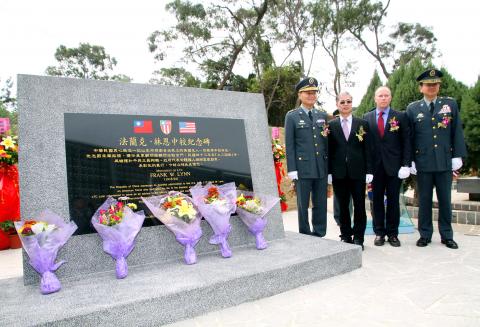The Kinmen Defense Command (KDC) unveiled a cenotaph on Tuesday to commemorate the late Lieutenant Colonel Frank Lynn of the US, who died in a Chinese artillery bombardment on Sept. 3, 1954, on Kinmen.
The monument was erected at Shueitou Wharf (水頭港) to mark the 57th anniversary of the attack and highlight the history of Taiwan-US friendship and the alliance that fought for democratic freedom, KDC officials said.
It was placed next to the cenotaph of Lieutenant Colonel Alfred Medendorp, which was installed at the wharf in August 1992. Medendorp was killed in the same bombing.

Photo: CNA
Aside from being an expression of gratitude, the cenotaphs are a reminder to future generations to treasure freedom and democracy and to help strengthen friendly relations between Taiwan and the US, said General Lee Hsiang-chou (李翔宙), who presided over the ceremony.
Chris Patton, a liaison officer at the American Institute in Taiwan, thanked Taiwan for constructing the monuments and saluting the officers for their sacrifice.
The cenotaphs are a witnesses to Taiwan’s role in maintaining peace in Asia and an emblem for fighters of peace, Patton said.
The cross-strait conflict of 1954 was an attempt by China to deter Taiwan from signing a bilateral security agreement with the US. The Chinese communists fired more than 100 artillery shells at Kinmen from military bases in Fujian Province.
KDC officials said the two Americans, who had volunteered to serve in Taiwan, sacrificed themselves for peace and justice, and their deaths indirectly hastened the signing of the Sino-American Mutual Defense Treaty between the Republic of China and the US in December 1954, which helped protect Taiwan from being invaded by China.
The treaty was terminated in 1980, a year after the US established diplomatic relations with China.

Taiwan is to commence mass production of the Tien Kung (天弓, “Sky Bow”) III, IV and V missiles by the second quarter of this year if the legislature approves the government’s NT$1.25 trillion (US$39.78 billion) special defense budget, an official said yesterday. Commenting on condition of anonymity, a defense official with knowledge of the matter said that the advanced systems are expected to provide crucial capabilities against ballistic and cruise missiles for the proposed “T-Dome,” an advanced, multi-layered air defense network. The Tien Kung III is an air defense missile with a maximum interception altitude of 35km. The Tien Kung IV and V

The disruption of 941 flights in and out of Taiwan due to China’s large-scale military exercises was no accident, but rather the result of a “quasi-blockade” used to simulate creating the air and sea routes needed for an amphibious landing, a military expert said. The disruptions occurred on Tuesday and lasted about 10 hours as China conducted live-fire drills in the Taiwan Strait. The Civil Aviation Administration (CAA) said the exercises affected 857 international flights and 84 domestic flights, affecting more than 100,000 travelers. Su Tzu-yun (蘇紫雲), a research fellow at the government-sponsored Institute for National Defense and Security Research, said the air

A strong continental cold air mass is to bring pollutants to Taiwan from tomorrow, the Ministry of Environment said today, as it issued an “orange” air quality alert for most of the country. All of Taiwan except for Hualien and Taitung counties is to be under an “orange” air quality alert tomorrow, indicating air quality that is unhealthy for sensitive groups. In China, areas from Shandong to Shanghai have been enveloped in haze since Saturday, the ministry said in a news release. Yesterday, hourly concentrations of PM2.5 in these areas ranged from 65 to 160 micrograms per cubic meter (mg/m³), and pollutants were

Taiwan lacks effective and cost-efficient armaments to intercept rockets, making the planned “T-Dome” interception system necessary, two experts said on Tuesday. The concerns were raised after China’s military fired two waves of rockets during live-fire drills around Taiwan on Tuesday, part of two-day exercises code-named “Justice Mission 2025.” The first wave involved 17 rockets launched at 9am from Pingtan in China’s Fujian Province, according to Lieutenant General Hsieh Jih-sheng (謝日升) of the Office of the Deputy Chief of the General Staff for Intelligence at the Ministry of National Defense. Those rockets landed 70 nautical miles (129.6km) northeast of Keelung without flying over Taiwan,